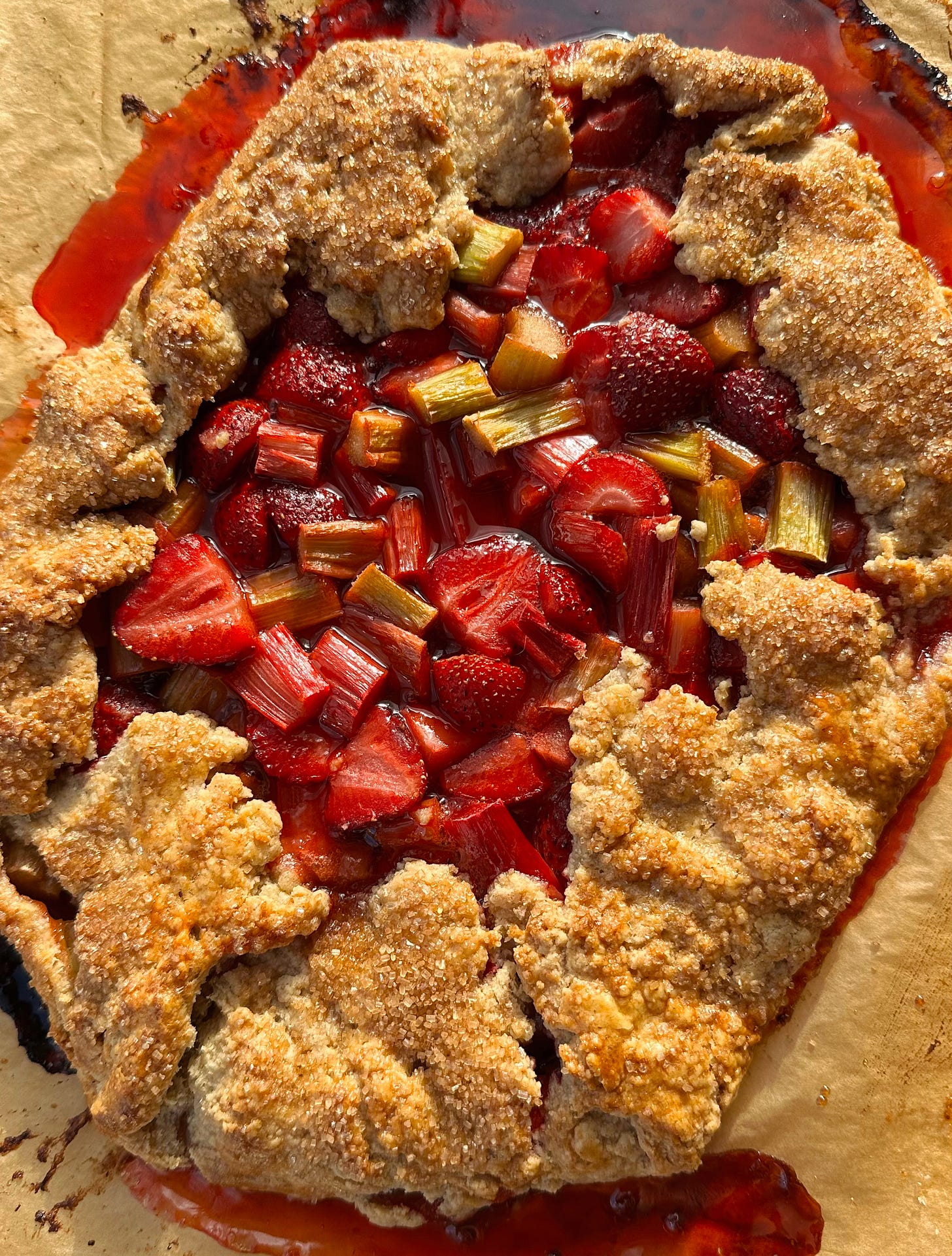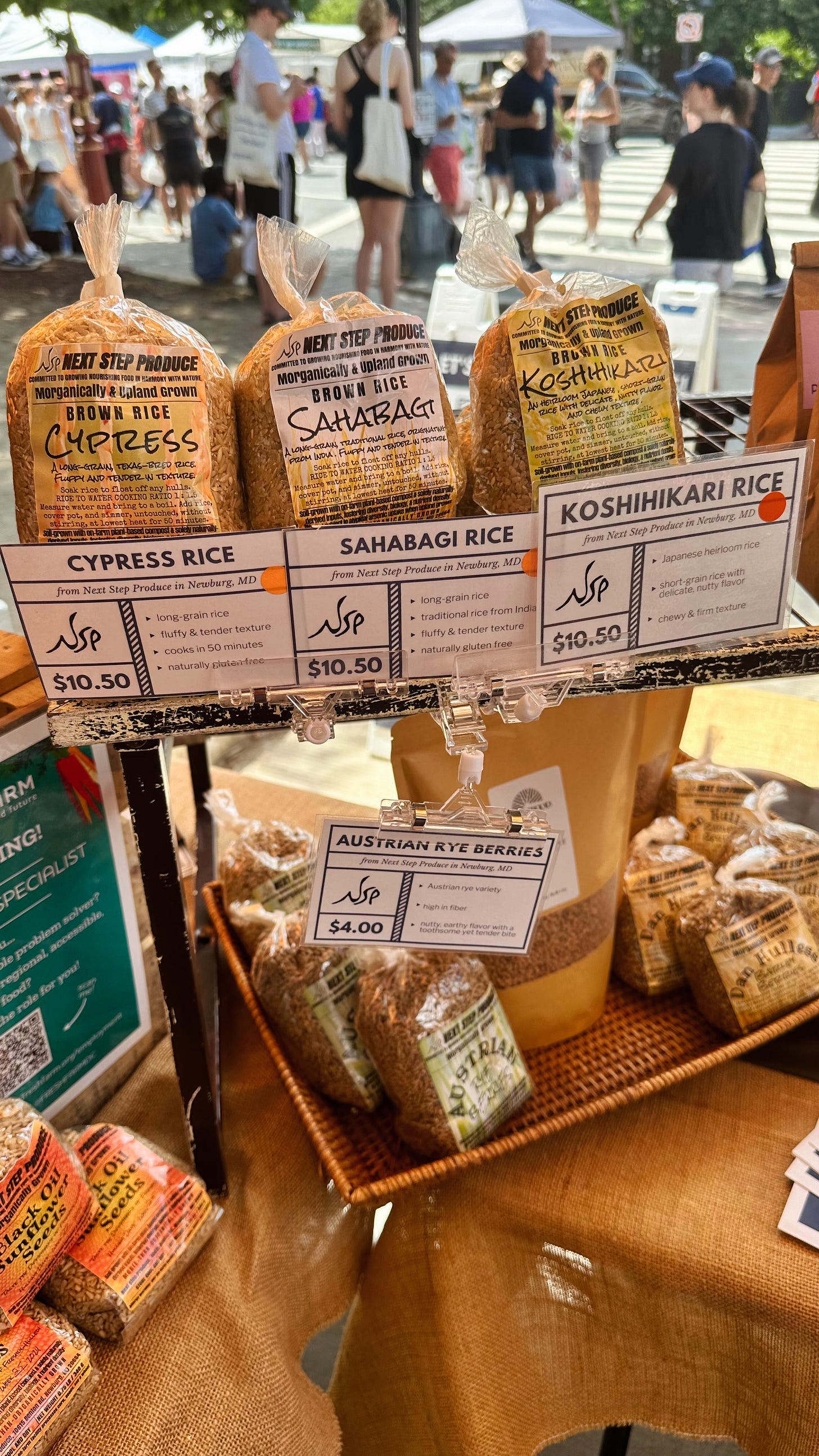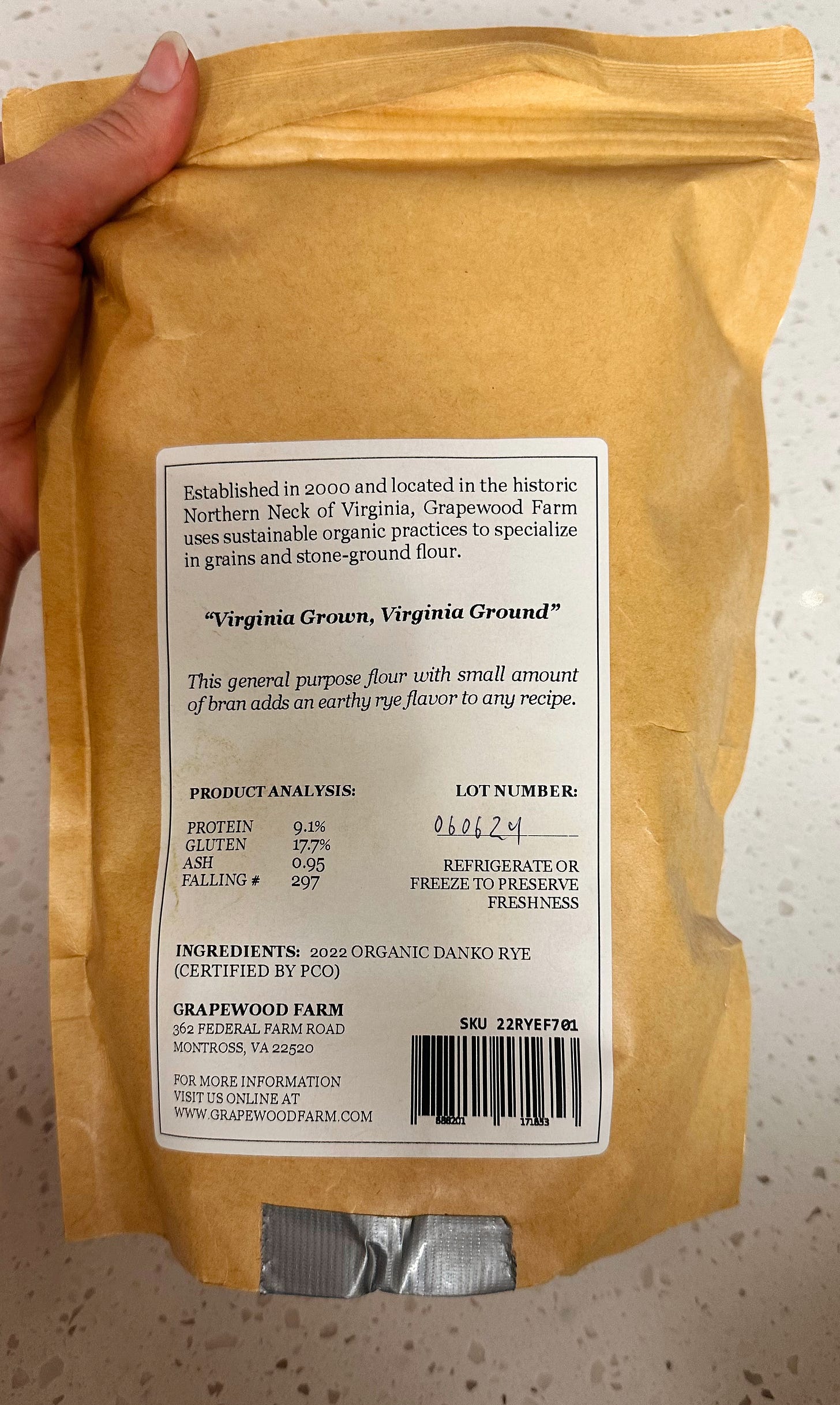Adding local grains to your farmers' market list 🌾
And a recipe for strawberry rhubarb galette with rye crust
Hi hangries! 🌾 Does anyone feel sad about summer ending even though we’re just hitting peak summer? For me, there is a uniquely summer problem where I feel the need to make the most of every weekend, use my apartment’s pool whenever possible, and, yes, make it to the farmers’ market every weekend. You may remember me talking about an endeavor a few summers back when I challenged myself to make a different pie every week. My passion for pies, crisps, crumbles, cobblers, and (this summer’s addition) galettes has continued. A true joy for me that I know so many other readers share is going to the farmers’ market to pick out fresh produce to take home and bake something up with.
Recently I’ve had the chance to learn about local grains. When we think about buying local, it’s usually fruits and vegetables that come to mind. A group called Common Grain Alliance (CGA) has stands at some DC-area farmers’ markets (Dupont, Silver Spring, Mosaic, and Arlington) where they sell flours, rice, popcorn, and other grains grown by farmers and produced by millers in the mid-Atlantic. They also connect those farmers and millers with bakeries, breweries, distilleries, and other local businesses who use their products to make healthier, tastier, and more unique products.
I stopped by CGA’s stand and picked up some rye flour since I have seen baking recipes that use it and have always wanted to try. I landed on making a strawberry rhubarb galette (my favorite dessert this summer) with a rye crust last week that was wildly delicious. The recipe comes later in the newsletter. The rye flour gave the crust a boost of nutty, earthy flavor and really amped up the rustic look and feel of the galette. It complemented the jammy strawberry rhubarb filling so well. I also got some buckwheat groats to try out as well as some yellow butterfly popcorn that I’ve already popped on the stovetop and was quite tasty.
Local, unique grains feel like entirely unexplored territory for me in the kitchen, and I think one of my next big baking adventures is incorporating these products more. To dive a bit deeper, I spoke with CGA executive director Madelyn Smith and want to share with you all what I learned. Madelyn breaks down what makes local grains healthier, why local businesses want to use them, and how she likes to use some of her favorite products.
Madelyn’s responses are shortened slightly to fit the length of the newsletter.
Hannah Gavin: Can you tell me about what the Common Grain Alliance does?
Madelyn Smith: Common Grain Alliance (CGA) started as a group of 13 founders — grain famers and an artisan mill that was buying local grain and making flour along with a bakery that was using that flour to make more nutritious grain products for their local community. They were already collaborating but looked around and didn’t see a lot of recognition of local grains as part of the local food movement. It’s common to find things like local fruits, vegetables, meats, and dairy at farmers’ markets, but it’s rare to go home with a bag of flour, some rice, or popcorn.
Grains have been really underrepresented in local food movement, and CGA’s mission is to change that. We are a membership organization of 130 primarily small businesses, including farmers, millers, distillers, brewers — some advocates and passionate home bakers too. We’re all working together to grow awareness around and consumption of the environmental, social, and individual health benefits of local grains.
Hannah: What makes local grains healthier than mass-produced grains?
Madelyn: There’s been a lot of talk in the news lately around the dangers of ultra processed foods. Many grains and bread products that people get from the grocery store fall into that category. A lot of bread products use things like dough conditioners and other chemicals to make them shelf stable.
Talking about flour specifically, wheat berry has three parts. The “germ” is the heart of the wheat kernel and contains most of fat, protein, minerals, and other nutrients — all the healthy stuff. The “endosperm” is the starch. And the “bran” is the external shell. Most commercial mills use roller mills that separate those three components, and white all-purpose flour is pretty much all endosperm — white starch. It’s not very good for you because it’s lacking the healthy stuff from the brown parts. They do that because it’s more efficient to produce this way. It’s one of the reasons for the demonization of carbs because the flour most people are eating is all simple starches with no nutritional value.
Most of the mills in the CGA network are using stone mills, where they crush the wheat berries between two pieces of stone that grind it. They can still sift out some of the bran and the germ out to make a finer flour, but they can’t fully separate the parts of that wheat berry. That’s why stone milled flour has a reputation for being more nutritionally dense compared to roller mill flour you get at the store.
Also, usually roller mills get really hot and burn off some of the fat, vitamins, and minerals in the flour. Good stone millers make sure to mill at a lower temperature to retain the nutritional benefits in the flour. That’s also why it’s important for your flour to be fresh, but when you buy flour at the grocery store, you have no idea how long it’s been there or where it comes from.
(Below is a video from Deep Roots Milling where they use a water-powered mill in Virginia. Also, Peirce Mill in Rock Creek uses a historic water-powered mill and hosts mill days once a month where they operate the mill for you to watch.)
Hannah: What are your conversations like with bakeries and other companies that want to be a part of CGA? What’s their motivation for using regional grains?
Madelyn: Many of the bakers who are committed to purchasing regional grain have a few motivations. One is that they want to provide the most flavorful and most nutritious food product to their customers. They’re in the pursuit of flavor. Commodity food systems and food companies optimize for volume and are not as concerned with flavor. When you get down to a more local scale, you can optimize for other things like using unique grain varieties.
A lot of bakers also want to know where their grain is coming from and speak directly to the farmers. Our current agriculture system is very anonymous — we don’t know where our grains come from usually. There’s a desire from CGA membe businesses to have that human connection and direct relationship to where their food is coming from.
It’s also a way to keep money in our regional economy. By buying local grains, you’re “voting with your dollar” and investing in the livelihoods of people in your community.
Hannah: What are some of your favorite products to use?
Madelyn: I get most excited about having access to a much bigger variety of grains. I’m a big fan of sorghum and buckwheat groats. I use sorghum and millet to diversify my grain bowls and grain salads, particularly in the summer. With the buckwheat groats, I love making granola. They add a really good crunchiness and nuttiness to the granola.
Hannah: How should people utilize Common Grain Alliance?
Madelyn: Our number one ask to people is to have them look at the grains they’re eating and see how much they can replace with local grains. CGA is a good source to find local grains with our grain stand program we have in collaboration with FRESHFARM. We also have a Shop Mid-Atlantic Grain page on our website for anyone who isn’t able to access those farmer’s market and can buy directly from our vendors. We have a depository of recipe ideas on our website too for anyone interested in that.
Strawberry Rhubarb Galette with Rye Crust 🍓
This recipe is adapted from Smitten Kitchen’s any-kind-of-fruit galette recipe with a few modifications. It makes for a fantastic dessert and even better breakfast. Read Smitten Kitchen’s recipe for using different fruit combinations and savory applications.
Ingredients:
Crust:
3/4 cup (99 grams) all-purpose flour
1/2 cup (66 grams) rye flour
1/4 teaspoon salt
1 1/2 teaspoons (6 grams) granulated sugar
8 tablespoons (4 ounces or 115 grams) cold unsalted butter, cut into pieces
1/4 cup (60 grams) plain yogurt or sour cream
3 to 4 tablespoons (45 to 60 ml) cold water
Filling:
1 1/2 cups fresh strawberries, quartered
2 cups fresh rhubarb, chopped into 1-inch pieces
2 tablespoons fresh orange juice
1/4 cup (50 grams) granulated sugar
1 1/2 tablespoons tapioca flour/starch
Pinch of salt
Pinch of ground nutmeg
Topping:
1 egg beaten with 1 teaspoon water (optional)
Turbinado or coarse sugar for sprinkling
Directions:
Make the pastry: Combine the all-purpose flour, rye flour, sugar, and salt in a large bowl. Sprinkle butter over dough and using a pastry blender or your fingertips, work it into the flour until the mixture resembles small peas. Sprinkle sour cream and 3 tablespoons water over mixture and stir/mash it together to combine; it should form large clumps; add last tablespoon water if it does not. Use your hands to bring it together into a single mass. Transfer dough to a large square of parchment paper, patting it into a flatter packet, and wrap it tightly. Chilling it in the fridge until firm, 1 to 2 hours or up to 4 days. You can hasten the firming process along in the freezer, for about 20 minutes.
Make filling: Combine strawberries, rhubarb, orange juice, sugar, starch, salt, and nutmeg in a medium bowl and set aside.
Assemble galette: Heat oven to 400°F and flatten the parchment paper that you wrapped your dough in on a large baking sheet. On a floured counter, roll the dough out into a large round-ish shape, about 14 inches across. Gently transfer it to the parchment paper in the pan. Spoon fruit filling and any juices that have collected into center, leaving a 2- to 3-inch border uncovered. Fold this border over fruit, pleating the edge to make it fit. The center will be open. For a darker, glossier crust, beat egg with 1 teaspoon of water and brush it over the crust. Sprinkle it all over with a generous layer of turbinado or coarse sugar.
Bake galette: For 30 to 35 minutes, or golden all over and the fruit is bubbling and juicy. Cool for at least 20 minutes on wire rack. Serve warm or at room temperature with whipped cream, vanilla ice cream, or on its own!
Do ahead: The galette will keep at room temperature for a few days and up to a week in the fridge.
You can learn more about Common Grain Alliance on their website and Instagram. Visit their Mid-Atlantic Grain Stand at FRESHFARM stands to check out their educational resources and buy some goodies of your own.
Thank you for reading, subscribing, and continuing to follow along at @hangrytohappyy on Instagram and @hangrytohappy on TikTok! See you here next time! Xoxo 🌾






Very interesting and informative! Really enjoyed!
Can I please order two slices of the Rhubarb pie two go??? Rye flour is an interesting choice that I would not have considered until I read this. Thanks HANNAH.